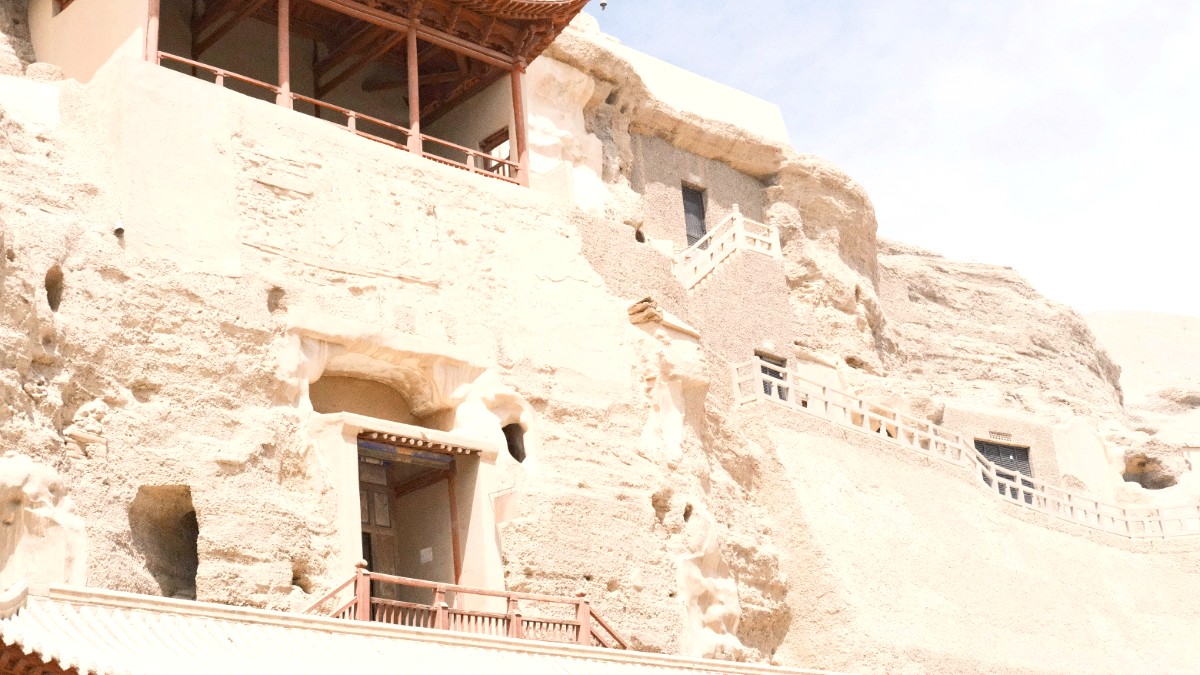
Gansu, China
The UNESCO World Heritage Site of the Mogao Grottoes is Dunhuang's crown jewel. These "Caves of a Thousand Buddhas" are a sprawling museum of human devotion and artistic skill, preserving murals and sculptures that narrate the spread of Buddhism and the cultural fusion that defined the Silk Road. The experience is both educational and deeply moving, providing context to Dunhuang's role as a spiritual and cultural crossroads.
Dunhuang is an oasis city, situated within the Gansu Province of China's remote northwest. Its location is unique, positioned at the westernmost stretch of the Hexi Corridor, a narrow, fertile band that served as the main thoroughfare for travelers and merchants traversing ancient trade routes. To its south and west, the vast expanses of the Gobi Desert and the formidable Taklamakan Desert stretch out, presenting a challenging but beautiful natural boundary.
The city rests at an approximate elevation of 1,138 meters (3,734 feet) above sea level. This elevation, combined with its arid continental climate, leads to extreme temperature variations. Summers are hot and dry, while winters bring intense cold. Despite these conditions, Dunhuang sustains itself as a verdant pocket, nourished by the Dang River and its tributaries, which flow from the Qilian Mountains to the south.
Dunhuang is a paramount place in the narrative of the ancient Silk Road, a network of trade routes connecting the East and West. For over a millennium, from the Han Dynasty (206 BCE – 220 CE) onwards, it functioned as a gateway, a military garrison, and a melting pot of cultures. Its strategic position at the confluence of various routes—leading westward into Central Asia, northward into Mongolia, and eastward into the heart of China—made it an unavoidable stop for merchants, missionaries, soldiers, and scholars.
The dissemination of Buddhism into China marks one of Dunhuang's most profound historical contributions. As Buddhist monks traveled from India through Central Asia, they found a welcoming environment in Dunhuang. This led to the creation of the Mogao Grottoes, a sprawling complex of Buddhist cave temples carved into the cliffs south of the city. The Mogao Grottoes evolved into the most significant repository of Buddhist art in the world, a living testament to the evolution of artistic styles, religious doctrines, and cultural interactions along the Silk Road.
Dunhuang's establishment as a military outpost and gateway.
Development of the Mogao Grottoes, creation of Buddhist art.
Unveiling of vast collection of ancient manuscripts and artifacts.
Guarding China's western frontiers, remnants of the Great Wall.
Meeting point for diverse cultures along the Silk Road.
The discovery of the Library Cave (Cave 17) at Mogao in 1900 further solidified Dunhuang's historical standing. This sealed chamber contained tens of thousands of manuscripts, scrolls, and silk paintings dating from the 5th to the 11th centuries. These documents, written in various languages, included Buddhist sutras, historical records, folk stories, and scientific texts, offering an unparalleled window into the political, social, religious, and economic life of the region during that period.
Dunhuang also was an important military garrison. It guarded China's western frontiers, protecting the Hexi Corridor from nomadic incursions. The remnants of the Han Dynasty Great Wall and the ancient Yumen and Yang Passes, located west of the city, are reminders of this defensive importance.
The historical significance of Dunhuang is not merely about its past grandeur; it is about its enduring legacy as a symbol of human connection, cultural synthesis, and the power of art and faith across vast distances and centuries. Visitors step into a story hundreds of years old, walking paths trodden by countless others who sought knowledge, wealth, or spiritual enlightenment.
The desert is not just a backdrop; it is an active participant in Dunhuang's story, influencing its defenses, its resources, and its enduring mystique.
Dunhuang is a city defined by its remarkable historical and natural treasures. It offers visitors an unique blend of desert landscapes, profound ancient Silk Road history, and unparalleled Buddhist art. The city itself, while modern in parts, serves mainly as a welcoming base for exploring these wonders, maintaining a relaxed pace compared to China's bustling metropolises.
Equally captivating are the Mingsha Sand Dunes, known as the Singing Sands Mountain, and the iconic Crescent Lake. This natural pairing presents a stunning contrast: vast, undulating golden dunes stretching to the horizon, with a miraculously enduring freshwater oasis shaped like a crescent moon nestled at their base.
Verdant pocket sustained by river flow, offering respite in arid lands.
Mogao Grottoes' unparalleled Buddhist murals and sculptures.
Mingsha Sand Dunes & Crescent Lake, unique natural pairing.
Dunhuang offers a focused travel experience. It is not a sprawling urban center but a manageable city where the main attractions are the historical sites and the natural desert environment. This allows for a more immersive visit without the distractions of large-city life.
Explore centuries of Silk Road history at a cultural crossroads.
Witness the world's most significant collection of Buddhist cave art.
Experience the stark majesty of the Mingsha Sand Dunes and Crescent Lake.
Dine on local street food and shop for unique souvenirs.
Learn more about Dunhuang's history and Silk Road artifacts.
Explore ancient military relics west of the city.